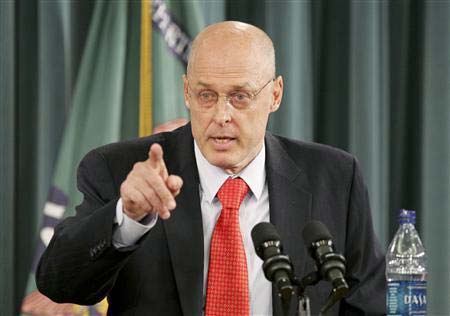Updated: 2008-11-13
[China Daily] WASHINGTON - The Bush administration on Wednesday largely abandoned its plan to buy up toxic mortgage assets and said it will focus its $700 billion financial bailout fund on making direct investments in financial institutions and shoring up consumer credit markets.
The US Treasury Department initially promoted the financial rescue package approved by Congress last month as a vehicle to buy illiquid mortgage assets from banks and other institutions to spur fresh lending.
|
|
However, that plan never got off the ground and US Treasury Secretary Henry Paulson told a news conference asset purchases were not the most effective use of the funds.
"This is not going to be the focus," he said. Paulson added, however, that the Treasury would continue to examine the usefulness of "targeted" purchases.
The US Treasury has already tapped the fund to inject capital into banks and ailing insurer American International Group (AIG). Paulson said he was considering a second round of preferred share purchases in both banks and non-bank institutions which, in a fresh twist, would match privately raised funds.
He also said the Treasury was working with the Federal Reserve on a plan to help restore credit flows to US households by using financial rescue funds to lure investors back to markets for securitized debt, such as car loans, student loans and credit cards.
The administration's shifting focus disappointed Wall Street and US stock prices tumbled sharply. The Dow Jones industrial average .DJI closed down 408 points, or 4.7 percent.
"This hasn't done the Treasury's credibility a world of good," said Alan Ruskin, chief international strategist at RBS Global Banking and Markets in New York. "Basically, they found that the market would applaud direct capital injections more readily than understanding the complexities of reverse auctions to buy assets, so it's a pragmatic choice."
Paulson was unapologetic, saying that by the time the rescue bill was passed on October 3, it was clear the asset purchase plan would take too long and would not be sufficient to calm roiling markets.
"I will never apologize for changing a strategy or an approach if the facts change," he said.
Cool to Calls for Help
The $700 billion financial sector bailout is the United States' marquee effort to combat a credit crisis spawned by rising US mortgage defaults that is now wreaking economic damage worldwide.
To help ease the crisis, the US Treasury and bank regulators on Wednesday issued "guidance" for banks encouraging them to lend and to rein in any compensation plans that might lead executives to take excessive risks.
Earlier on Wednesday, Canada announced a plan to buy up another $41 billion in insured mortgages and other steps to try to free-up credit.
Paulson said the US Treasury was duty-bound to help prevent mortgage foreclosures, but he warned that further aid would likely mean a significant government subsidy, signaling a lack of support for a Federal Deposit Insurance Corp. proposal for more aggressive aid to borrowers.
Paulson sidestepped questions on whether the Treasury would use bailout funds to help struggling Detroit automakers, as the industry and some lawmakers have called for.
While he said the industry was a "critical" one for the United States, he said the purpose of the program was to provide financial system stability.
He said one option would be to amend legislation to allow $25 billion already approved for efficient vehicle production to be made available more quickly.
So far, the Treasury has focused on providing capital to federally regulated banks and thrifts, but Paulson said it was looking to broaden the effort to cover financial institutions that do not have a federal bank or thrift charter.
"Although the financial system has stabilized, both banks and non-banks may well need more capital given their troubled asset holdings, projections for continued high rates of foreclosures and stagnant US and world economic conditions," he said.
$700 Billion Still Enough?
The Treasury has allocated $250 billion of the bailout funds to direct capital injections into banks and thrifts and it has earmarked another $40 billion to shore up AIG, leaving just $60 billion to dole out before it would have to ask Congress to release the final $350 billion.
Paulson said he had no timeline for that request, which means the decision could be left to the incoming administration of President-elect Barack Obama, who takes office on January 20.
He also signaled he would not seek to increase the overall size of the bailout fund. "I still am comfortable that, with $700 billion, we have what we need," he said.
With an aim to restoring credit for households, Paulson said the Treasury and Fed were considering setting up a program to increase liquidity for top-rated asset-backed securities, but he provided few details.
"The initial shock of abandoning TARP is hitting stocks, but the support for consumer-level lending may be a silver lining as it goes to the root of what's ailing the economy, namely personal consumption," said Brian Dolan, chief currency strategist at FOREX.com in Bedminster, New Jersey.









No comments:
Post a Comment